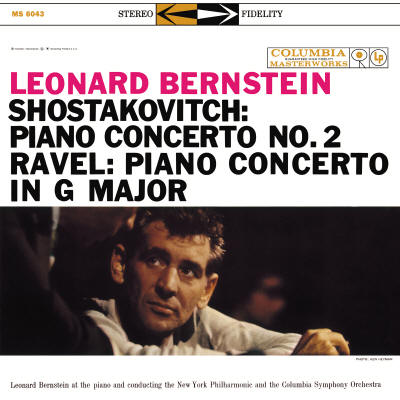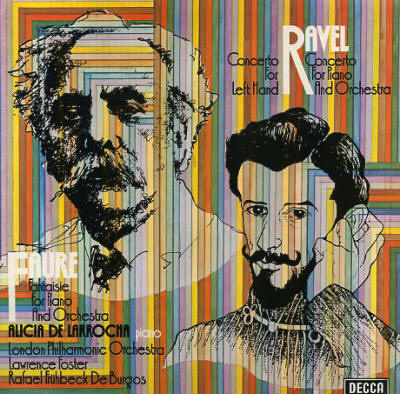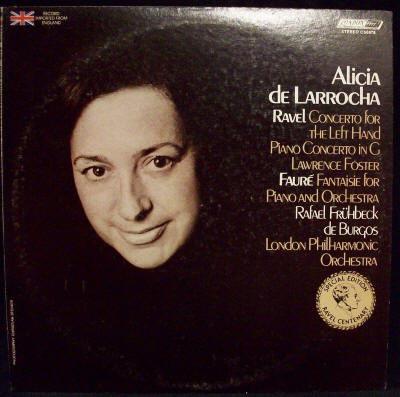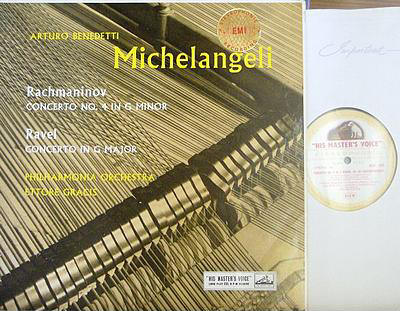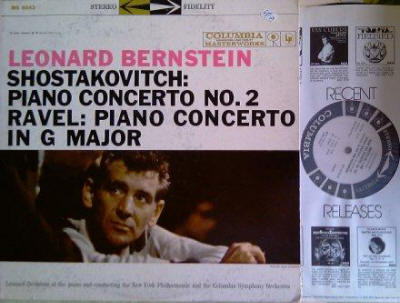|
You are reading the older HTML site
Positive Feedback ISSUE 56
Vinyl Reissue of
Columbia MS 6043
Impex Records reissue of Columbia MS 6043 – Shostakovitch Piano Concerto No. 2 with the New York Philharmonic and Ravel Piano Concerto in G Major with the Columbia Symphony Orchestra, Leonard Bernstein conducting both works from the piano. Many vinyl lovers are familiar with Cisco Music. For twenty years Cisco reissued music from many genres of music on 180 gram vinyl, on Gold CDs, on SACDS, and on regular CDs. They also imported direct from Japan the 180 gram Super Analogue Disc LPs. These LPs were primarily reissues of classical music off of the London (Decca) label. While a small company, Cisco Music was well known and respected in the audiophile reissue business. At the start of what the media is now calling “The Great Recession” Cisco, like many other High End companies, suffered a severe drop in revenues. Rather than trying to endure the financial losses Cisco closed its doors. Like a phoenix arising from the ashes of Cisco Music, comes Impex Records, Inc. All of the key personnel from Cisco are now the key employees of Impex Records. Impex Records is currently pressing and selling some of the LPs from the final Cisco catalog. In addition to reissuing some of the old Cisco catalog, Impex is starting to release new reissues of recordings that have never been reissued. One of these new, never before reissued, LPs is Columbia MS 6043. When I heard that MS 6043 was going to be reissued I was elated. In the heyday of stereo analog recordings (roughly 1954 to 1983) there were four recordings of the Ravel and two recordings of the Shostakovitch that stood above all others in terms of performance. MS 6043 contains two of those six great performances. As soon as I got my hands on the Impex Records reissue of MS 6043 I fired up the stereo and pulled my original Columbia first pressing (six eye) of MS 6043 from the shelf along with the other four great performances. I also pulled an additional recording of the Shostakovitch that I thought would make for an interesting comparison. For the Shostakovitch I pulled EMI ASD-2709, Lawrence Foster conducting the Royal Philharmonic Orchestra with John Ogden as soloist with the extra LP being Angel Seraphim 60161, Andre Cluytens conducting the French National Radio Orchestra with Dmitri Shostakovitch, the composer, as soloist. For the Ravel I pulled EMI ASD-255 (also available as Angel S35567), with Ettore Gracis conducting the Philharmonia Orchestra with Arturo Benedetti Michelangeli as soloist, Decca SXL6680/London CS 6878, Lawrence Foster conducting the London Philharmonic Orchestra with Alicia de Larrocha as soloist, and Deutsche Grammophon 139349 (also available as DG 664109), with Claudio Abbado conducting the Berlin Philharmonic Orchestra with Martha Argerich as soloist. With LPs in hand I played the MS 6043 reissue of the Ravel. The piece opens with a whip crack. The whip crack was loud and startled me in my seat. I immediately reached for the volume control thinking that the volume was set too high. It turned out that the volume was set correctly. It is just that the reissue is very dynamic. The Ravel reissue was made from the original three track masters. It is a very dry studio recording recorded at the 30th Street Studio that was the recording site of many famous recordings. In this recording the piano is front and center with the orchestra arrayed behind it. You are sitting in row 1 and can just about reach out and touch the piano. The recording was crystal clear and dead quiet. Both the piano and each solo instrument in the orchestra were highly detailed. If you have heard the Cisco reissue of Capitol SP 8374, Britten - Young Person's Guide to the Orchestra and Dohnanyi - Variations on a Nursery Tune this reissue of MS 6043 is very similar to the Capitol in its ability to let you hear every single detail. After playing the reissue Ravel I played the Ravel on the original MS 6043. For a Columbia LP the sound of the original was remarkably good. You would not mistake it for an RCA, EMI, or Decca/London but it was very acceptable. The original, in comparison to the reissue, was noisier and not as detailed. The original was also warmer in sound than the reissue. This may have been due to the tube gear used through out the recording and production chain. The additional warmth does make the sound seem more natural, but it seems to obscure some of the fine inner detail. I then played the De Larrocha Ravel, followed by the Michelangeli, the Argerich, and finally the reissue for a second time. Then the cycle was repeated. As the LPs played I listened to the performances comparing them one to the other. The Ravel piano concerto is not a piece that requires blazing virtuoso technique. It is a work that requires a high level of interpretive skills and also the ability to recreate the sound pictures that Ravel had written. The De Larrocha Ravel was a quiet, conventional performance which ably demonstrated De Larrocha's superb technique and her interpretive skills. I found it a little boring though the sound was impeccable. The Michelangeli Ravel had a slightly faster tempo and was more spirited, more animated than the De Larrocha. Even in the slow, soft second movement the quiet music came alive due to the interpretive skills of the pianist. The final third movement was played at a fast pace. It was a controlled, restrained performance—no pyrotechnics, just beautiful music. The Argerich Ravel surprised me. I love Argerich and her mighty left hand. For this performance, however, there was no thundering left hand. It was a subtle and in many ways an almost delicate performance. The first movement was lively. In the second movement she created an impressionistic painting of a summer afternoon lying under a tree watching the clouds float by. As I listened my entire body relaxed as I drifted along with the music. The third movement was played very fast. There was a tension underlying the music that was not in the other performances. This tension kept me on the edge of my seat, riveted to the music.
The Bernstein Ravel is quite different from the others. That is not unusual. There is no question that Bernstein, as a conductor, marched to a different drum. Because he was usually pushing the envelope his performances varied in quality. Some of his performances were clunkers. After you heard them you immediately thought ‘What the Heck Was He Thinking'. Then you hear one of his legendary performances and your jaw drops to the ground as you sit there in total awe. Bernstein's Ravel is one of those legendary performances, though maybe not of the same magnitude of greatness as his Stravinsky/Rite of Spring on Columbia MS 6010. In over fifty years I have never heard a performance, live or recorded, of the Rite of Spring that has matched MS 6010 for primal energy or savagery. Ravel's Piano Concerto in G was a favorite of Bernstein's and he had been playing it fairly frequently with the New York Philharmonic and its predecessor since 1944. The first movement of Bernstein's Ravel is fast paced with incredible energy. Towards the end of the movement the music becomes driven forward as an inner energy keeps building and building until it explodes. The slow second movement reminds me of Eric Satie's Gymnopodies. Simple music being simply played allowing the sheer beauty of the music to come forth. This movement more than the other two shows to me what great skill Bernstein had as a pianist. Lots of people can play loud and fast. It takes talent to play something slow and simple and make it come alive. The final movement is very fast paced. Unlike some of Bernstein's performances where he shoves the pedal to the metal at the finale that does not happen here. Despite the fast pace it is a restrained performance. The music bubbles over with energy and excitement. Again the music builds an inner energy that drives the music forward to the conclusion. The final notes do not end as a mighty crescendo. Played at a moderate volume the final notes hang, suspended in mid air. This is a perfect way to end this great piece of impressionistic music. If I could only have one performance of the Ravel I would choose the Bernstein for its incredible energy and the smile it brings to my face. And yes, the audiophile quality sound is also very nice.
Unlike the Ravel Piano Concerto in G which is played quite often in the concert hall, Shostakovitch's two Piano Concertos are rarely heard. This is a shame as both concertos are brilliant compositions. The First Piano Concerto is very modern and it is understandable as to why would-be concert-goers do not line up to buy tickets. The Second Piano Concerto, which is on MS 6043, is totally different. It is written in a classical style (think Rachmaninoff) that is readily accessible by today's listeners. Shostakovitch's Second Piano Concerto was used as the music in the Toy Soldier segment of Disney's Fantasia 2000. How much more mainstream can music get than being used in a Disney animated feature film? When listening to the Shostakovitch I first played the Impex reissue, then the Seraphim with Shostakovitch as soloist, then the EMI with John Ogden, the original Columbia MS 6043, and then a second listen to the Impex reissue. I repeated the cycle a second time. The MS 6043 Shostakovitch was recorded differently from the Ravel. The Shostakovitch is from a two track master tape and was not recorded in a studio but in the Colorama Ballroom of the Saint George Hotel where a number of early Bernstein stereo recordings were made. Because of the recording venue the recorded sound is much more realistic; i.e. it sounds similar to what I hear in the concert hall when I go to concerts. You are also sitting in row 4 instead of row 1. The recording is dead quiet. The sound is very detailed, but not as detailed as the Ravel because the microphones are further away from the instruments as opposed to being on top of them. However, the instruments now blend together as an ensemble as opposed to being separate instruments playing simultaneously. Do you want to hear minute detail of each instrument or do you want to hear an orchestra playing as a whole? You can not have both.
Hearing Shostakovitch's mono 1957 performance is breathtaking. What many people forget is that Shostakovitch was as brilliant a pianist as he was a composer. This performance shows Shostakovitch, the pianist, at his best. The tempos of the first and third movements are blazingly fast. It is also obvious that he was having a lot of fun during this performance. This piece had special meaning for him as he had written it the previous year for his son, Maxim, to perform in concert. Here was Dad being given a chance to show his son how the piece should really be played. The Ogden performance is also fast paced, though slower than the Shostakovitch performance. In the first movement Ogden's playing is crisp and clean. He does not pound the keys as some performers do. He is forceful, but he also balances the piano's volume against the instruments. Volume increases when playing with the full orchestra. Volume decreases when playing with only the piccolos. The slow second movement is played very much in a Rachmaninoff style—lyrical and flowing. In the final third movement Ogden is not as forceful or as loud as he was in the first movement. He blends in with the orchestra, but pops out occasional to display his virtuosity. A very well balance performance, a very exciting performance. The Bernstein performance is different as the piano is much closer to you than in the other performances. Thus, the piano could dominate the sound, though it never does. In the first movement where the piano and the piccolos are playing together it sounds like Bernstein is really pounding the keys. However, the volume of the piccolos and the piano are perfectly balanced. Despite Bernstein's apparent pounding of the keys the performance of the first movement is light and whimsical with emphasis on the jazz elements. The slow second movement is low key. The simple piano notes are highlighted against the back drop of the orchestra. Bernstein plays with much feeling. The second movement is calm and tranquil so that you can rest up for the energetic third movement. The third movement is fast paced. The soloist and the orchestra are having a great time. The music is happy, fun, and witty. All too soon the movement is over. The best way to describe this performance is that it is really fun to listen to. Again, if I could have only one recording it would be the Bernstein. Both the Impex reissue and the EMI Ogden have excellent sound. So that is not an issue. I find the Ogden performance to be exciting. The Bernstein, however, is both exciting and fun. In case of tie, go with the fun. In conclusion, the Impex reissue of Columbia MS 6043 has wonderful audiophile sound and two great performances of very accessible 20th Century classical music. For US$32.98 it is highly recommended. Impex Records 818-535-5052
|

